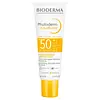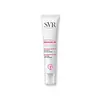What's inside
What's inside
 Key Ingredients
Key Ingredients

 Benefits
Benefits

 Concerns
Concerns

 Ingredients Side-by-side
Ingredients Side-by-side

Water
Skin ConditioningDibutyl Adipate
EmollientDiethylhexyl Butamido Triazone
UV AbsorberDiethylamino Hydroxybenzoyl Hexyl Benzoate
UV FilterDicaprylyl Carbonate
EmollientDiisopropyl Sebacate
EmollientBis-Ethylhexyloxyphenol Methoxyphenyl Triazine
Skin ConditioningCorn Starch Modified
AbsorbentGlycerin
HumectantPolyglyceryl-6 Stearate
Emollient1,2-Hexanediol
Skin ConditioningMicrocrystalline Cellulose
AbsorbentC20-22 Alkyl Phosphate
EmulsifyingC20-22 Alcohols
Emulsion StabilisingCaprylyl Glycol
EmollientPolyglyceryl-6 Behenate
Emulsion StabilisingCellulose Gum
Emulsion StabilisingEctoin
Skin ConditioningMannitol
HumectantXylitol
HumectantO-Cymen-5-Ol
AntimicrobialXanthan Gum
EmulsifyingRhamnose
HumectantSodium Hydroxide
BufferingButyl Methoxydibenzoylmethane
UV AbsorberTocopherol
AntioxidantPropylheptyl Caprylate
EmollientWater, Dibutyl Adipate, Diethylhexyl Butamido Triazone, Diethylamino Hydroxybenzoyl Hexyl Benzoate, Dicaprylyl Carbonate, Diisopropyl Sebacate, Bis-Ethylhexyloxyphenol Methoxyphenyl Triazine, Corn Starch Modified, Glycerin, Polyglyceryl-6 Stearate, 1,2-Hexanediol, Microcrystalline Cellulose, C20-22 Alkyl Phosphate, C20-22 Alcohols, Caprylyl Glycol, Polyglyceryl-6 Behenate, Cellulose Gum, Ectoin, Mannitol, Xylitol, O-Cymen-5-Ol, Xanthan Gum, Rhamnose, Sodium Hydroxide, Butyl Methoxydibenzoylmethane, Tocopherol, Propylheptyl Caprylate
Water
Skin ConditioningDiisopropyl Adipate
EmollientDiethylamino Hydroxybenzoyl Hexyl Benzoate
UV FilterDicaprylyl Ether
EmollientEthylhexyl Triazone
UV AbsorberSilica
AbrasiveBis-Ethylhexyloxyphenol Methoxyphenyl Triazine
Skin ConditioningCetearyl Alcohol
EmollientC12-15 Alkyl Benzoate
AntimicrobialDiethylhexyl Butamido Triazone
UV AbsorberCeteareth-20
CleansingHydrogenated Vegetable Oil
EmollientGlycerin
HumectantPentylene Glycol
Skin ConditioningAcrylates/C12-22 Alkyl Methacrylate Copolymer
1,2-Hexanediol
Skin ConditioningNiacinamide
SmoothingPolyester-7
Skin ConditioningHydroxyethyl Acrylate/Sodium Acryloyldimethyl Taurate Copolymer
Emulsion StabilisingDipotassium Glycyrrhizate
HumectantNeopentyl Glycol Diheptanoate
EmollientCaprylyl Glycol
EmollientArginine
MaskingXanthan Gum
EmulsifyingCoco-Glucoside
CleansingTocopherol
AntioxidantCitric Acid
BufferingGlycine Soja Oil
EmollientDisodium Lauryl Sulfosuccinate
CleansingPolysorbate 60
EmulsifyingSorbitan Isostearate
EmulsifyingLecithin
EmollientRosmarinyl Glucoside
AntioxidantCaffeyl Glucoside
AntioxidantGallyl Glucoside
AntioxidantLepidium Sativum Sprout Extract
Skin ConditioningWater, Diisopropyl Adipate, Diethylamino Hydroxybenzoyl Hexyl Benzoate, Dicaprylyl Ether, Ethylhexyl Triazone, Silica, Bis-Ethylhexyloxyphenol Methoxyphenyl Triazine, Cetearyl Alcohol, C12-15 Alkyl Benzoate, Diethylhexyl Butamido Triazone, Ceteareth-20, Hydrogenated Vegetable Oil, Glycerin, Pentylene Glycol, Acrylates/C12-22 Alkyl Methacrylate Copolymer, 1,2-Hexanediol, Niacinamide, Polyester-7, Hydroxyethyl Acrylate/Sodium Acryloyldimethyl Taurate Copolymer, Dipotassium Glycyrrhizate, Neopentyl Glycol Diheptanoate, Caprylyl Glycol, Arginine, Xanthan Gum, Coco-Glucoside, Tocopherol, Citric Acid, Glycine Soja Oil, Disodium Lauryl Sulfosuccinate, Polysorbate 60, Sorbitan Isostearate, Lecithin, Rosmarinyl Glucoside, Caffeyl Glucoside, Gallyl Glucoside, Lepidium Sativum Sprout Extract
 Reviews
Reviews

Ingredients Explained
These ingredients are found in both products.
Ingredients higher up in an ingredient list are typically present in a larger amount.
1,2-Hexanediol is a synthetic liquid and another multi-functional powerhouse.
It is a:
- Humectant, drawing moisture into the skin
- Emollient, helping to soften skin
- Solvent, dispersing and stabilizing formulas
- Preservative booster, enhancing the antimicrobial activity of other preservatives
You might know this ingredient as Tinosorb S or Bemotrizinol. It is a UV filter that covers both UVA and UVB rays.
This ingredient has two peak UV absorption peaks ( 310 and 340 nm) and is able to absorb both UV-A and UV-B rays. This ingredient works by preventing UV rays from reaching and damaging your skin.
On top of that - it is highly photostable and helps prevent the photodegration of other sunscreen ingredients such as avobenzone.
Tinosorb S is allowed in the EU, Australia, and Asia. It is close to being approved by the FDA and we'll hopefully get this ingredient in the U.S. by late 2025.
Fun fact: Tinosorb S is the most effective UV absorber at maximum concentration (measured by SPF) permitted in the EU.
This ingredient is oil-soluble, so your oil-cleansers will take this right off at night.
Learn more about Bis-Ethylhexyloxyphenol Methoxyphenyl TriazineCaprylyl Glycol is a humectant and emollient, meaning it attracts and preserves moisture.
It is a common ingredient in many products, especially those designed to hydrate skin. The primary benefits are retaining moisture, skin softening, and promoting a healthy skin barrier.
Though Caprylyl Glycol is an alcohol derived from fatty acids, it is not the kind that can dry out skin.
This ingredient is also used as a preservative to extend the life of products. It has slight antimicrobial properties.
Learn more about Caprylyl GlycolDiethylamino Hydroxybenzoyl Hexyl Benzoate (DHHB) is a chemical UV-A absorber. It is formulated for high UVA protection (320-400 nm).
DHHB is well-liked for:
DHHB has been approved by the EU, Japan, Taiwan, and South America for use up to 10%. Unfortunately, it has not been approved for use in the US or Canada due to slow regulatory processes.
This ingredient is soluble in oils, fats, and lipids.
Learn more about Diethylamino Hydroxybenzoyl Hexyl BenzoateDiethylhexyl Butamido Triazone is a photostable UV absorber. It protects in both the UVB and UVA II range.
The great thing about this ingredient is that it is ultra-photostable at low concentrations.
It is also pretty water-resistant and is highly oil-soluble (so your oil cleanser will get it off right away).
This ingredient is currently available in Europe and Japan, but not in the US.
Learn more about Diethylhexyl Butamido TriazoneGlycerin is already naturally found in your skin. It helps moisturize and protect your skin.
A study from 2016 found glycerin to be more effective as a humectant than AHAs and hyaluronic acid.
As a humectant, it helps the skin stay hydrated by pulling moisture to your skin. The low molecular weight of glycerin allows it to pull moisture into the deeper layers of your skin.
Hydrated skin improves your skin barrier; Your skin barrier helps protect against irritants and bacteria.
Glycerin has also been found to have antimicrobial and antiviral properties. Due to these properties, glycerin is often used in wound and burn treatments.
In cosmetics, glycerin is usually derived from plants such as soybean or palm. However, it can also be sourced from animals, such as tallow or animal fat.
This ingredient is organic, colorless, odorless, and non-toxic.
Glycerin is the name for this ingredient in American English. British English uses Glycerol/Glycerine.
Learn more about GlycerinTocopherol (also known as Vitamin E) is a common antioxidant used to help protect the skin from free-radicals and strengthen the skin barrier. It's also fat soluble - this means our skin is great at absorbing it.
Vitamin E also helps keep your natural skin lipids healthy. Your lipid skin barrier naturally consists of lipids, ceramides, and fatty acids. Vitamin E offers extra protection for your skin’s lipid barrier, keeping your skin healthy and nourished.
Another benefit is a bit of UV protection. Vitamin E helps reduce the damage caused by UVB rays. (It should not replace your sunscreen). Combining it with Vitamin C can decrease sunburned cells and hyperpigmentation after UV exposure.
You might have noticed Vitamin E + C often paired together. This is because it is great at stabilizing Vitamin C. Using the two together helps increase the effectiveness of both ingredients.
There are often claims that Vitamin E can reduce/prevent scarring, but these claims haven't been confirmed by scientific research.
Learn more about TocopherolWater. It's the most common cosmetic ingredient of all. You'll usually see it at the top of ingredient lists, meaning that it makes up the largest part of the product.
So why is it so popular? Water most often acts as a solvent - this means that it helps dissolve other ingredients into the formulation.
You'll also recognize water as that liquid we all need to stay alive. If you see this, drink a glass of water. Stay hydrated!
Learn more about WaterXanthan gum is used as a stabilizer and thickener within cosmetic products. It helps give products a sticky, thick feeling - preventing them from being too runny.
On the technical side of things, xanthan gum is a polysaccharide - a combination consisting of multiple sugar molecules bonded together.
Xanthan gum is a pretty common and great ingredient. It is a natural, non-toxic, non-irritating ingredient that is also commonly used in food products.
Learn more about Xanthan Gum